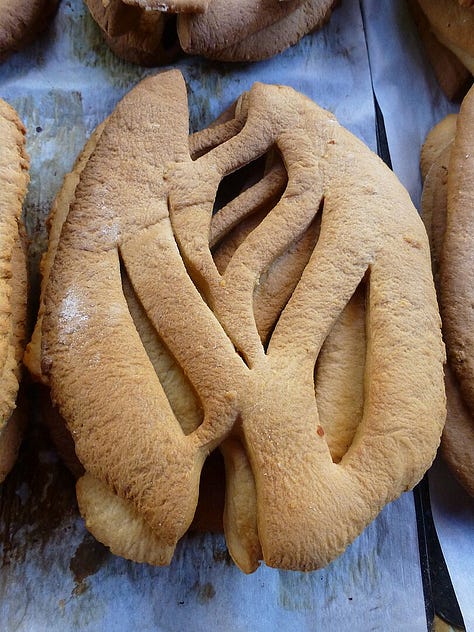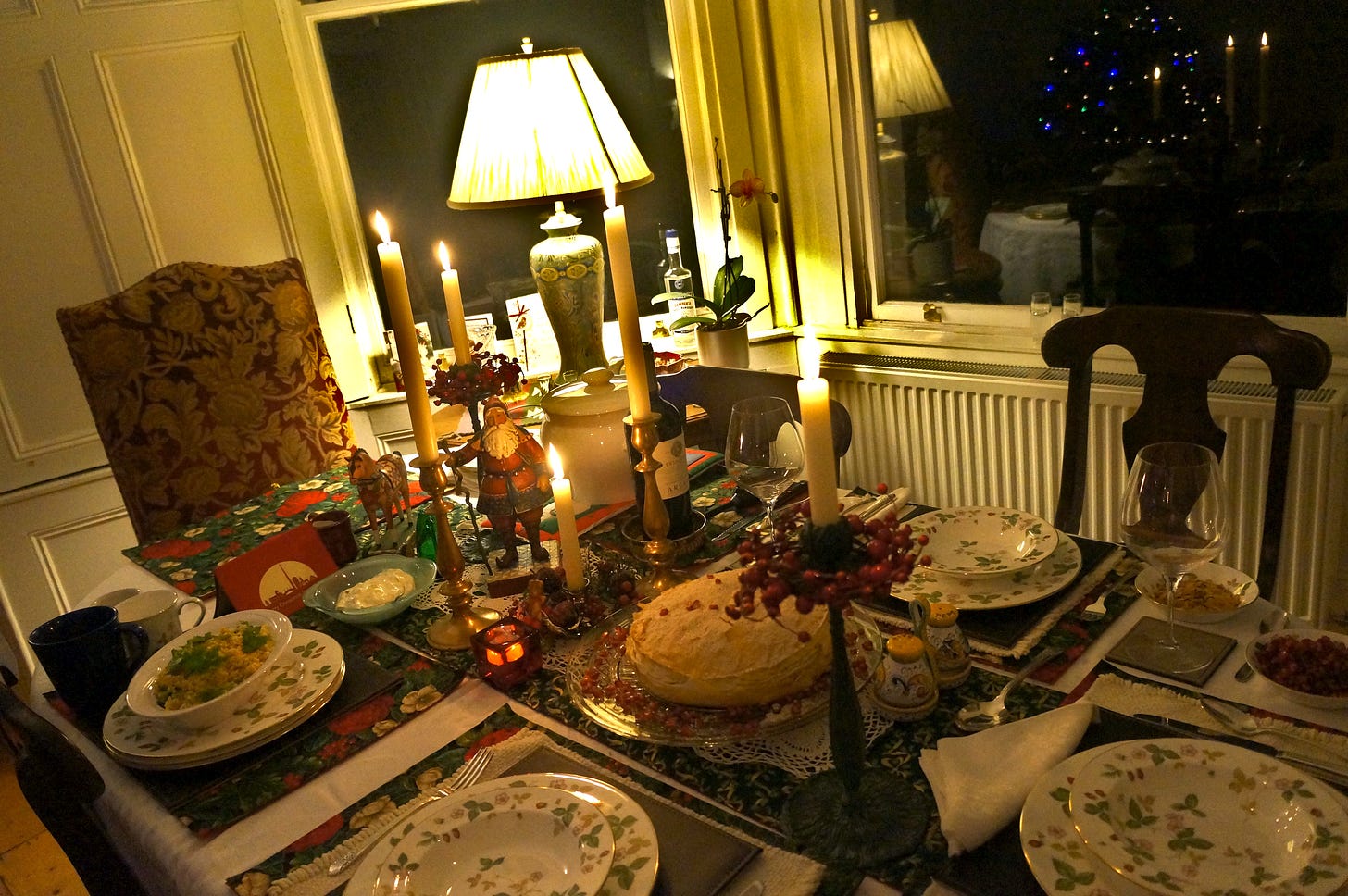On Christmas Day this year, 2024, we will mark our third Christmas as residents of Nice, France, a city that lies within the political region of Provence-Alpes-Côtes d’Azur and, in historical terms, the geographical region of Provence. It will be our sixth Christmas celebration here, since my family visited twice while living in Dublin to pass the end-of-year holidays. However, this will be the first year we observe the Provencal tradition of the Treize Desserts, or the 13 Desserts of Christmas.1
I admit, the concept of celebrating Christmas with a plethora of desserts has a certain hedonistic appeal. As a Christmas tradition, however, the celebration is shaped by religion and religious symbolism. The desserts are intended to follow “le gros souper,” or “big supper” (generous but not extravagant), which precedes midnight Mass on December 24, although attendance at Mass these days is surely exceptional. The table is to be laid with three white cloths and three candles, symbolic of the Holy Trinity, and an extra place at the table should be made, should someone less fortunate and in need of food happen to pass by.
The desserts are laid out thereafter for diners to sample, traditionally upon returning from the midnight Mass, and remain on the table for the following three days.
As you can see, the symbolism of the tradition of the treize desserts is distinctly religious. The number thirteen represents the twelve apostles and Jesus, that is, the attendees at the Last Supper. The desserts do not, however, correspond precisely to each of those individuals present at the Last Supper. Four of the apostles are in effect replaced symbolically by the four Catholic mendicant orders, i.e., the religious orders whose existence depends on the generosity of Christian donors. These desserts are called “Li pachichoi” in the Provencal language (les quatre mendiants in French, or the four beggars in English), representing the Carmelites, Franciscans, Dominicans, and Augustinians. Each order has some association with a dessert, such as nuts, dried figs, almonds, raisins, and dates, where the colour of the fruit is seen as corresponding to the colours of the orders’ everyday vestments.
The other desserts are more variable, but generally include nougat and a particular kind of cake. The nougat is of two kinds, seen as representing evil and good—a hard “black nougat” with honey and almonds (nougat noir au miel), and the more familiar soft “white nougat” (nougat blanc), made with sugar, eggs, pistachios, honey, and almonds.
The cake is commonly a pompe à huile. No, it is not an “oil pump.” Rather it is a first-cousin of a traditional Provencal fougasse, having a characteristic shape and made with water, flour, sugar, yeast, orange flower water, olive oil and oranges.2 It is a strictly seasonal food. In some parts of Provence the cake might instead be a gibassier—another cousin of the fougasse, seasoned with anise and, unlike the pompe à huile, produced year-round. Either way, when serving one must never use a knife to cut it; the belief is, to avoid misfortune in the new year, it must be broken by hand, as Christ broke bread at the Last Supper. The cake can also be dipped in the vin cuit3 which in earlier times would have been an essential accompaniment to the treize desserts, having a spiritual association with the blood of Christ.



The cake, be it a pompe à huile or gibassier, also connects to another Provencal tradition, the painted clay figures called “santons” that populate the many elaborate crèche displays found throughout the region at Christmastime. In particular, the cake is usually carried to the birthplace of Jesus by a character called Pistachié (or Pistachier), a common farmhand of questionable character who, in scenes of the crèche, brings the newborn gifts of fish, sausage and a fougasse, gibassier or pompe à huile.4
Apart from the more or less essential components of the treize desserts already described, there can be great variety based on location and terroir, family tradition or simply personal taste and whimsy. In Aix-en-Provence, for example, one might consider it essential to include the signature confection of that city, the calisson—a tender cookie-like sweet made with marzipan and melon conserve—or biscotins, a confection comprised of a roasted hazelnut coated with a thin layer of pastry seasoned with orange blossom water.
As we have inherited no direct regional or family tradition, this year we have extraordinary freedom in assembling our treize desserts de Noël, potentially establishing a precedent for future Christmas Eve dinners. Since we are in Nice, local specialties are inevitable—the ubiquitous oreillettes or bugnes will likely be there, anticipating the Carnaval season. Possibly also a delicious tourte de blette, a pastry made with chard, pine nuts and raisins dusted with confectioner’s sugar.5 And so many other things to choose from:
Confit and dried fruits of all kinds
Cumin and fennel seed cookies
Pain d'epices (spice cake)
Pâte de coing (quince paste)
All manner of winter fruits, particularly apples and pears
Marrons glacés (glazed chestnuts)
As newcomers we might dare to introduce some chocolate delights from one of the excellent chocolatiers in the city, or even a bûche de Noël, which could amount to mixing traditions from one place and time with another. There is also the option of purchasing a pre-assembled treize desserts tin. So many choices!
As for the gros souper, I think we’ll fall back on more familiar customs. A staple in past years has been roast beef with Yorkshire pudding, glazed shallots, carrot and parsnip purée, and rich dark gravy. Last year it was roast pork, slow-cooked with dry apple cider from Normandy, and a sauce seasoned with herbs and honey from Monastère-Cabrespines in Aveyron.6 So good—we spoke about it for days afterward. One year when we were still living in Dublin we reasoned that Christmas celebrated an event that took place in the Orient, and dared prepare a more exotic repast: a splendid lamb tagine sprinkled with parsley and festive pomegranate seeds and a beautiful pastilla. The food was lovely and I still like the concept.
No matter the dinner choice, I’m already looking forward to participating in the tradition of les treize desserts.
The tradition of the treize desserts is discussed in many places, and the following list comprises a bibliography of sources helpful to me in understanding the tradition.
Géraldine Barthélémy-Melani, “La Tradition des 13 desserts en Provence,” Maison du Parc des Alpilles https://www.parc-alpilles.fr/wp-content/uploads/sites/2/2021/12/La-Tradition-des-13-desserts-.pdf (consulted 16 November 2024)
“Noël en Provence : la tradition des treize desserts,” Rocher Mistral (08/12/2021) https://www.rochermistral.com/noel-provence-tradition-treize-desserts/ (consulted 16 November 2024)
“La liste des 13 desserts dans le repas de Noël de la tradition provençale,” made in marseille (10 décembre 2023) https://madeinmarseille.net/32231-13-desserts-noel-provence/ (consulted 16 November 2024)
“Thirteen Desserts,” Wikipedia https://en.wikipedia.org/wiki/Thirteen_desserts (consulted 16 November 2024)
You can find an easy-to-make recipe here: https://www.atelierdeschefs.fr/recettes/12844/pompe-a-l'huile/.
See “Qu’est-ce que le vin cuit?” Trois Fois Vin [blog] https://www.troisfoisvin.com/blog/quest-ce-que-le-vin-cuit/ (consulted 17 November 2024)
The story of Pistachié is elaborated here: “L’histoire du Pistachié,” Santons Fouque https://www.santons-fouque.fr/fr/p/27-histoire-du-pistachie (consulted 17 November 2024)
Find recipes for this and other typically niçois foods to include among the treize desserts at “Les 13 desserts de Noël,” L’atelier Cuisine Niçoise, Patrimoine https://cultivez-vous.nice.fr/patrimoine/les-13-desserts-de-noel/ (consulted 17 November 2024)
See “L’excellence pour les Compagnons du miel du Monastère-Cabrespines“ La Dépêche (3 June 2023) https://www.ladepeche.fr/2023/03/06/lexcellence-pour-les-compagnons-du-miel-du-monastere-cabrespines-11040579.php (consulted 17 November 2024)






Love this ! Joyeux Noël 🎄
This was fascinating! I know, or at least thought I knew, about the 13 desserts, but was not aware of all of the religious symbolism. I’ve always thought it would be fun to do, even if we don’t have all of the usual components here.
And how interesting that you buy honey from Aveyron! Where do you get it? The producers you mentioned are not that far from where we live, but I hadn’t heard of them before. But I just looked it up and there are 1,109 beekeepers registered here! That doesn’t mean they are all making and marketing their own honey, but it does seem to me that we have a lot to choose from here.